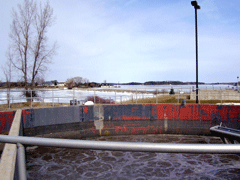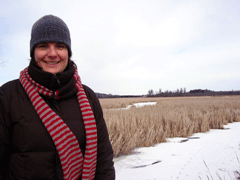Toward Healthier Waters
Air Date: Week of March 6, 2009

The village of Clayton’s sewage treatment ponds are just a few hundred feet from the St. Lawrence River. (Photo: David Sommerstein)
President Barack Obama has set aside half a billion dollars to clean up the Great Lakes. Many environmentalists - and some politicians - say the project is long overdue. The lakes are polluted with toxic waste that poison fish and endanger human health, and invasive species which disrupt the food web and the marine ecosystem. North Country Public Radio’s David Sommerstein reports.
Transcript
GELLERMAN: It’s Living on Earth, I’m Bruce Gellerman.
For decades the Great Lakes have been in deep trouble. They contain a fifth of the world’s fresh water but the five lakes suffer from massive pollution, degraded wetlands and invasive species.
Cleaning them up will cost tens of billions of dollars - and as North Country Public Radio’s David Sommerstein reports, President Obama’s economic stimulus package makes a down payment to begin the process.
[SOUND OF RIVER IN WINTER]
SOMMERSTEIN: The ice is finally breaking up on the St. Lawrence River. But it’s still frigid outside. This is the Thousand Islands region of Upstate New York, where the eastern-most Great Lake, Lake Ontario, empties into the St. Lawrence. Pine-crested islands with quaint cottages dot the channel. Canada’s on the far shore of the steel blue expanse.
It’s a long way from the industrial hum of Buffalo, Detroit, or Chicago. But even here, the water isn’t as clean as it looks.
[SOUND OF RIVER IN WINTER]
SOMMERSTEIN: I’m standing here on the docks of the village of Clayton right here on the St. Lawrence River. Right where I’m standing is one of the outflows of the village of Clayton’s sewer system, so on really rainy days, poorly treated sewage will actually spew out into the St. Lawrence River right here.
[SOUND OF TREATMENT PONDS]
CADDICK: Clayton’s sewer system was put in a century ago.
SOMMERSTEIN: Jennifer Caddick points to treatment ponds just a few hundred feet from the water. She directs the environmental group, Save the River. Caddick says towns like this don’t have money to upgrade.
CADDICK: Throughout the whole Great Lakes region, hundreds of billions of gallons of untreated sewage or poorly treated sewage are released into our waterways each year.

Jennifer Caddick of Save the River is bundled up on French Creek, a tributary of the St. Lawrence River that provides critical wetlands habitat. (Photo: David Sommerstein)
And there’s almost half a billion dollars more for a battered watershed. Toxic sediments from Rust Belt factories poison fish and endanger human health. Jeff Skelding says more than 180 invasive species have entered the Lakes, most of them hitchhikers in the ballast water of foreign ships….
SKELDING: Causing incredible disruption of the food web and the ecological system.
SOMMERSTEIN: Not to mention billions of dollars in economic damage every year.
Skelding is national campaign director for the Healing Our Waters-Great Lakes coalition. He says now the Great Lakes are on the map.
SKELDING: At the highest levels of power in Washington, we have two strong Great Lakes champions.
SOMMERSTEIN: That would be President Obama and his Chief of Staff, Rahm Emmanuel, both Illinoians.
It’s an about face from the previous administration. President Bush did convene more than a thousand stakeholders to hammer out a strategy for cleaning up the Great Lakes in 2005. Skelding says there was lots of lip service but not a lot of money.
SKELDING: It was a very heady time. President Bush had issued an executive order declaring the Great Lakes a national treasure and setting up the regional collaboration. The challenge became how do we secure the funding. It was at that point that things began to slow down.
SOMMERSTEIN: Things only sped up during the presidential campaign. Then candidate Obama vowed to create a $5 billion trust fund for the Lakes. Supporters see the new budget plan as a down payment on that promise.
New York Democratic Senator Kirsten Gillibrand says the money will help the region’s decimated economy as much as its environment.
GILLABRAND: Through new construction, through tourism dollars, through property value impact. It’s something that’s real. So I’m hopeful that we can make the case to our colleagues that investing in the Great Lakes is a win-win for everyone.

The village of Clayton’s sewage treatment ponds are just a few hundred feet from the St. Lawrence River. On really rainy days, the sewage backs up into the river.(Photo: David Sommerstein)
STACK: It’s unrealistic and unfair to think that the U.S. can and will clean up the Great Lakes without Canadian input. They simply can’t do it.
SOMMERSTEIN: So far, Canadian Prime Minister Stephen Harper has been quiet on matching Obama’s commitment.
[SOUND OF CRUSHING ICE]
SOMMERSTEIN: Back in northern New York State, environmentalist Jennifer Caddick tests the ice on French Creek, a tributary of the St. Lawrence River. She says wetlands like these are the heart and lungs of the Great Lakes.
CADDICK: If you come out here in the spring and summer, it’s really incredible, you can see the fish migrating up to spawn, or heading back to the river after they’ve been born, there’s lots of birds chirping around, lighting on all the cattails and other wetland vegetation here, so this is really a thriving area for wildlife in the region.
SOMMERSTEIN: The Bush-era clean-up blueprint called for $20 billion in projects to bring the Great Lakes back to health by restoring wetlands that have been plowed under for strip malls, for example.
So far, many environmentalists are hopeful President Obama is the guy who’ll get some of those projects done.
For Living on Earth, I’m David Sommerstein in Clayton, New York.
Links
Great Lakes 2005 Regional Report
Living on Earth wants to hear from you!
Living on Earth
62 Calef Highway, Suite 212
Lee, NH 03861
Telephone: 617-287-4121
E-mail: comments@loe.org
Newsletter [Click here]
Donate to Living on Earth!
Living on Earth is an independent media program and relies entirely on contributions from listeners and institutions supporting public service. Please donate now to preserve an independent environmental voice.
NewsletterLiving on Earth offers a weekly delivery of the show's rundown to your mailbox. Sign up for our newsletter today!
 Sailors For The Sea: Be the change you want to sea.
Sailors For The Sea: Be the change you want to sea.
 The Grantham Foundation for the Protection of the Environment: Committed to protecting and improving the health of the global environment.
The Grantham Foundation for the Protection of the Environment: Committed to protecting and improving the health of the global environment.
 Contribute to Living on Earth and receive, as our gift to you, an archival print of one of Mark Seth Lender's extraordinary wildlife photographs. Follow the link to see Mark's current collection of photographs.
Contribute to Living on Earth and receive, as our gift to you, an archival print of one of Mark Seth Lender's extraordinary wildlife photographs. Follow the link to see Mark's current collection of photographs.
 Buy a signed copy of Mark Seth Lender's book Smeagull the Seagull & support Living on Earth
Buy a signed copy of Mark Seth Lender's book Smeagull the Seagull & support Living on Earth

